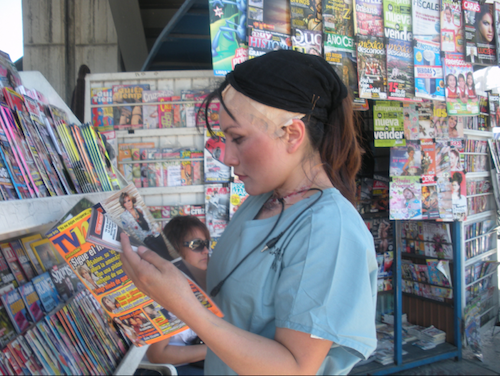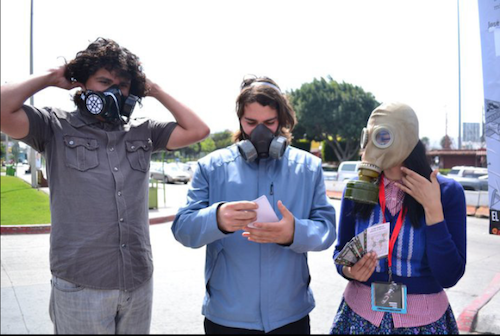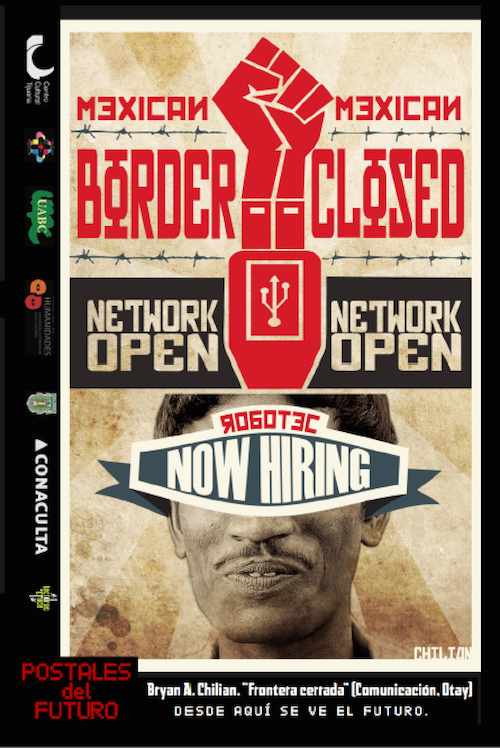Siren Aria (a fragment)
…It’s still conductive, pornographic. The plumbing a listening hose for
strangers rooting around
In the house’s howls: I unwelcome Pan-
Am out of breath.
Fearing the mammograph.
Does one Sioux Chief Full-Slip Repair Coupling from south of Peculiar,
Missouri glued after the other,
Inhaled, make an argument? Does the rig an epic?
Do the Inca chesspieces on the cover of ERR-0’s 1967 annual report,
Handcrafted for Executive W. Clement Stone of Chicago Illinois
From ERR-0 de Pasco silver
Freed to find its own competitive price? Youths of Chules
On chemical scholarship framed to admire the panorama of their boss
drill. 6000 kilometers Northwest, spec
House razed a year past: Berkshire Hathaway signs suspend from
demure midmod fence. Third-degree
Kith and kin. Would-be Lombardi ransacked in skin, futzing with
copper elbows, inhaling multipurpose Sureflex:
Lord, make me a pipe of your benefiguring.
This is no structuralist’s wet dream.
Wipe yourself off & fasten the screen.
I couldn’t write it in sentences. I couldn’t compose sentences. I couldn’t
compose sentences
Without her hands.
Because I couldn’t bear to look at the totality of it.
The infrastructure sucks in her.
Inarticulate for centuries: a Southern repulse to the scene of repair
Nurses the axe to free the artifacts from the sentences they were
destined to make.

There’s a crucial moment in F.T. Marinetti’s prologue to the Founding and Manifesto of Futurism, first published on the front page of Le Figaro in 1909, that oozes of futurism and atavism, fusing nursing and manufacturing, milk and the waste products of industrial progress, racism and cloying sentimentality in a way I still haven’t been able to unsnarl after years of reading. Marinetti’s birth as a Futurist takes place following a minor car accident on the industrial periphery of Milan in his new Fiat convertible, when he ends up in a trench teeming with factory sludge:
I stopped short, and to my disgust rolled over into a ditch, with my wheels in the air. . .. Oh! Maternal ditch, brimming with muddy water! Fair factory drain! I gulped down your bracing slime, which reminded me of the sacred black breast of my Sudanese nurse…. When I climbed out—a filthy, stinking rag—from underneath the capsized car, I felt my heart being slashed, deliciously, with the red-hot iron of joy!
What’s stunning is how baldly this Futurist depicts the European, and specifically Italian, need to nurse itself on the colonial exploitation of Africa in order to propel its culture into the future. Marinetti’s father was a lawyer from Piedmont specializing in commercial contracts, who decided to try his luck in Alexandria following the opening of the Suez Canal. Marinetti uses images of his childhood in Egypt, concoctions of exoticism and nostalgia, to justify imperial violence throughout his career. In this notorious avant-garde origin story, Africa supplies the natural and human resources that make the future possible; elsewhere he describes the arms and breasts of his “nutrice sudanese” in relation to coal, as “color carbone coke.” But these resources are simultaneously confused with the detritus of industrial processes. The milk (or petroleum) of origins and the stain of waste are imbibed simultaneously in the factory channel to fuel the phallic surge of the newborn Futurist, who does not emerge immaculate, but cast as a filthy, fetid rag. Restless with the “imprisoned radiance of electric hearts” prior to this red-hot release from the maternal ditch, Marinetti condenses and foretells a history of exploitation that is the basis of his fatherland’s technological rise in a single image of nursing, from the Italian colony in Libya to be established several years later and a repercussive century of oil, gas, and refugee flows, to Fascist imperial war in East Africa, to the ‘Ndrangheta’s shipping of toxic and radioactive waste to Somalia (and the endangerment or assassination of writers attempting to expose it).
The figure of the nurse recurs in Marinetti’s last-ditch effort at an “aeronovel or aeropoem,” the 1943-44 Venezianella and Studentaccio—a title I’ve translated as Venezianella the Futurist to echo Marinetti’s first “African novel,” Mafarka the Futurist. In a bizarre 125-page hallucination of “words-in-freedom” dictated and transcribed by his wife, daughters, and colleagues shortly before his death, Marinetti glorifies Venezianella, a Red Cross nurse who returns wounded from the besieged Lybian port of Tobruk to the city of her mother, Venice. The aesthetically bruised nurse is healed and enrobed by Futurist glassblowers wielding the forces of amalgamation, working from cauldrons of Sicilian lava and copper furnaces (a term commonly accepted as the etymological root of the word ghetto) in St. Mark’s Square. Hemmed in by the gloom of a civil war legible only in glimpses, they go on to forge a New Venice modeled after her: a glass colossus merging chunks of Venice’s “mobile mosaic of detritus,” clashing clusters of “immensified” Venetian monuments making up a kitschy gown, juste-au-corps and bonnet, all supplemented and stylistically “corrected” by a hanging thicket of tropical African trees along her waistline. The nurse-effigy’s dimensions rival New World skyscrapers of steel and glass to form a would-be colonial pastiche of architectural styles and natural resources fraught with the wistful fantasy of resuscitating Italy’s failed project of nationhood.
Even the figure of the Red Cross nurse, seemingly extraterritorial, is fraught with Italian nationalist overtones, since it was the horror of carnage in the (successful) Second Italian War for Independence against Austria that inspired the Red Cross’s formation. Still, the nurse figure fascinates for its confessional quality: its unmasking of conduits of dependence, carnal and geological, in the crusade for electrification and speed at every foreign and domestic cost. This is why I’ve chosen to work on translating Venezianella into English, despite the intense reaction of revolt it provokes in me.
Spanning the Futurist’s career, the perpetual nurse seems to offer the promise of fodder for a way ahead in the most exhausted of landscapes, but also renders the matrix of any future manifest in the flesh. The nurse acts as conduit for traffic of sustenance, exploitation, and repair that verse, if it’s to make anything of its received condition of lineation—of trenches mimicking the plough’s turning—would do well to graph.
In discussing the constant quibbles over the genealogy of originality in the avant-garde, Lawrence Rainey provides a useful corrective to Futurism’s paranoid claims to being first:
Modernism, together with its intense vehicle the historical avant-garde…offered not a history of beginnings and developments, but a protracted series of endings, innovations that swiftly exhausted themselves, corridors that always had “no exit” written irrevocably on the farthest wall. Futurism was just that. Alluring, vulgar, ludicrous, chilling, monstrous, farcical, grim—it remains one of the great dead ends of modernism.
Lately, in a continually aborted effort to chart the great chain of irresponsibility that led to my cul-de-sac’s cancer cluster and the ongoing poisoning of neighborhoods thousands of miles away, I’ve tried to track not only the dead ends but the smothered beginnings of development, milk (or formula, for that matter) and sludge. It’s a maddening process that returns one to the elements and their media of conveyance.

Wild air, world-mothering air,
Nestling me everywhere,
[…]
[…] that’s fairly mixed
With, riddles, and is rife
In every least thing’s life;
This needful, never spent,
And nursing element;
Serving as parish priest in the slums of manufacturing cities, where coal was being burned at unprecedented rates to fuel Britain’s rise to power, Gerard Manley Hopkins understood that the air was both perpetually available and perpetually endangered—via harm to the atmosphere—by the very sun: “flashing like flecks of coal,” and potentially “In grimy vasty vault.” Hopkins’s iambic tetrameter, and the alliteration that forces awareness of exhalation effects, draws you to huff and puff your way through these lines, becoming aware, in breathlessness, of air as nurse that sustains or harms us.
I’ve asked myself what form poetry would need to take now to chart the sometimes nurturing, though more often sickening, unwitting kinship structures in which we participate daily—like the narrative structures drawn by Mark Lombardi until his suicide. I am asking this on a blog with a lifeblood in big pharma ((NYSE:LLY)). I am asking over the internet.
My family actually has a problem with nurses. I mean they tend to make us lose consciousness. We’re vasovagal, meaning (as I’ve learned by way of Bhanu) that we turn into turtles in anxious situations, switching on the oldest, reptilian elements of our autonomic nervous system—so the sight or threat of the merest bit of blood can lead to marvels of time-travel. Hard-wired as such from a childhood in which illness meant trips to anonymizing public clinics, I’ve heard the tired slogan “mind over matter” all my life to no avail. No doctors in sight within my immediate family, no lawyers. I failed on that score by choosing poetry.
There’s some hope for the next generation. My niece was born three months premature and those long weeks of many moons ago being pricked from a transparent box made her suprainsensitive to pain; she’s now a coed cheerleading world champion and oncology nurse. My nephew, caving to parental pressure as a teenager, went to school in computer science instead of staying on with jazz and becoming a music teacher. He started working in the defense industry, justifying his days by telling himself he was working strictly on the military’s protective gestures rather than invasions. After five years, it became unbearable and he quit. He’s now a pediatric nurse in the intensive care unit of a neonatal ward. Success.
At least on the immediate score. Medical schools and hospitals everywhere are sponsored, as Anne Boyer reminds us, by financiers.
But there’s some residual hope for poetry in charting potential channels of care as well as damage. Emma Goldman was a trained nurse, after all, from the time she was imprisoned in the penitentiary on Blackwell’s Island, and as Barbara Ehrenreich and Deirdre English pointed out over forty years ago, with Silvia Federici more recently, witches, midwives and nurses have played key roles in undoing the damage of some sponsored acts of rationalization. It turns out, as I’ve known all my life from fainting and not, that prosodic voices have a discernible effect on the reaction to trauma; they signal safety. Singing, chanting, the development of slow exhales, and playing wind instruments can mitigate trauma, like touch.
Phonemic Emanation Sample # 1 from daria fain on Vimeo.
The Commons Choir’s DIAPHRAGMATIC AH HA HA AH HA AH CHORUS LINE seems to be about this possibility of tuning and mitigation as much as it is about atonement for the trauma inflicted by English as the linguistic vehicle of globalization.

There’s some residual hope in occupied channels of custody, however barbed, like those of Pepe Rojo and his students at the Autonomous University of Baja California. In the semi-extraterritorial interventions of Desde Aqui Se Ve El Futuro (You Can See the Future from Here), the Tijuana Liberation Front (FLT) supplied U.S. tourists with vengefully inverted science fiction narratives from the “past” of Tijuana ((whose time zone is two hours behind the cities just North of the border), where technology is not manically generated or luxuriated in, but suffered.
There’s hope in the group’s anti-prosodic gestures and chants from chorus lines of cyborg-nurses foretelling apocalypses already secured, underway, and hope in the processions of Santa ste.la, the patron saint of technological accidents, modeled after an elderly woman at the border who didn’t know how to work an elevator. Striking up conversations with people crossing into Mexico “to scare away the future,” they forged relations where relationality is neutered. While under the current regime of border-crossing, “co-operation” passes through obstacles as readily as x-rays and electromagnetic fields do, and social separation is a gulf that fortune has spared us “the necessity of contributing at all publicly to bridge,” these artists strip away the bandages to repair—with one-way calls from telephone booths, tongues deenglished and apples of knowledge run amok, as disjointed wires and unyoked cables take the place of stethoscopes.
An artist, translator, and teacher, Jennifer Scappettone was born and raised in New York and earned ...
Read Full Biography

